List of fish in the River Trent
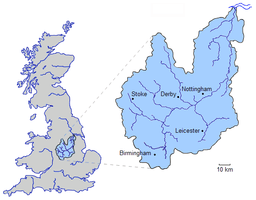
This list of fish in the River Trent is a list of fish species that have been recorded from the River Trent, a major river in England that starts in Staffordshire, flows through the Midlands, and joins the River Ouse to form the Humber Estuary.
The impressive diversity of fish species in this river has been known (and celebrated) since 1590, with poetry containing the earliest mention that the Trent contains 30 kinds of fish. The earliest actual list of fish in the river is from 1641. Over the centuries some species have since become locally extinct, and other species have been introduced.
Earliest literary references
In 1590, Edmund Spenser in The Faerie Queene described the River Trent and its fish fauna as follows:[3]
- The beauteous Trent which in itself enseams,
- Thirty kinds of fish and thirty different streams.
This couplet was closely echoed in 1612, in Drayton's Poly-Olbion description of the Trent:[4]
- Or thirty kinds of fish that in my streams do live
These poems have been a source of curiosity to a number of fishing experts, who have endeavoured to guess the identity of the thirty fish alluded to in the poems.
1641 list
The earliest known list of fish from the River Trent was from 1641. Although the list contains thirty names, one of them is not a fish by modern standards, but an edible crustacean, the Crayfish. The list also includes some fish names that no longer exist in modern English, such as "Frenches" and "Lenbrood"; these species are therefore currently unidentifiable.[5]
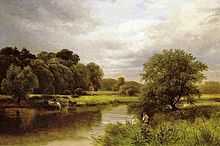
The 1641 list of 30 species (verbatim, note antique spelling of some names):
Barbet, Bream, Bullhead, Burbolts, Carp, Chevin, Crayfish, Dates, Eel, Flounder, Frenches, Gudgeon, Grayling, Lampern, Lamphrey, Lenbrood, Loach, Minnows, Pickeral, Pinks, Perch, Roach, Ruff, Salmon, Shad, Smelt, Sticklebats, Sturgeon, Trout, Whitling.
Note on the Sturgeon
The largest of these fish was the Sturgeon, a species which at one time was fairly frequently caught in the Trent, but only in low numbers. Notable examples included a sturgeon of eight feet taken near Donington castle in 1255, and another at nearby King's Mill of seven feet in 1791.[1] The last known catch was in 1902 near Holme, Nottinghamshire; the fish was eight and a half feet long and weighed 250 pounds.[2]
1676 description
In 1676 in Izaak Walton described the River Trent as "One of the finest rivers in the world and the most abounding with excellent salmon and all sorts of delicate fish."[6]
Walton also speculated (incorrectly) that the name of the River Trent might be based on the number of fish species, that the Trent is "... so called from thirty kind of fishes that are found in it, or for that it receiveth thirty lesser rivers".[7]
1751 list
In 1751, Charles Deering provided a list of 34 kinds, under the title An alphabetical list of all the fish catch’d in the River Trent. This listed read (verbatim);
Barbel, Bream, Bulhead, Burbot, Carp, Chub, Crayfish, Dace, Eel, Flounder, Grayling, Gudgeon, Lamprey, Lampern, Loach, Minnow, Muscle, Perch, Pike, Roach, Rud, Ruff, Salmon, Salmon Trout, Salmon Pink, Sand Eel, Shad, Smelt, Strickleback, Sturgeon, Stream Pink, Tench, Trout, and Whitling.[8]
This list also includes several unrecognizable fish. It also lists three different names for salmon, as well as "Whitling", which is a name for a young male trout, and "Muscle", which is probably a reference to freshwater mussels, formerly used as food in some areas.
1829
Glover reproduced Deering's list in his History and Gazetteer of the County of Derby,[9] and also provided further information on many of the then known species in the companion volume, The History of the County of Derby (Volume 1).[1]
1985
In 1985, a study of anglers' catches stated that the ‘Trent supports about 40 species’, but they were not listed. The fish that were caught most often, and were important to anglers, included barbel, bream, bleak, carp, chub, dace, eel, gudgeon, perch, and roach.[10]
2007 non-native species
Non-native species that had a sustainable population in the river were listed in 2007, and included the European Bitterling (Rhodeus amarus), Carp (Cyprinus carpio), and Zander (Sander lucioperca).[11][12]
Master list
This list is based on Deering's 1829 list. It includes the locally extinct species as well as the more recent additions, but it does not claim to be fully comprehensive; other species may occur in the river but are as yet undocumented.
| Number | Name | Image | Other names | Species name in 1829[1] Modern species name | Notes | References |
|---|---|---|---|---|---|---|
| 1. | Barbel |  | Barbet | Cyprinus Barbus Barbus barbus | [9] | |
| 2. | Bitterling |  | European Bitterling | Not listed in 1829 Rhodeus amarus | Non native | [11] |
| 3. | Bleak |  | Cyprinus Alburnus Alburnus alburnus | [10] | ||
| 4. | Bream |  | Cyprinus Brama Abramis brama | [9] | ||
| 5. | Bullhead | .jpg) | Bulhead River Bullhead | Cottius Gobio Cottus gobio | [9] | |
| 6. | Burbot |  | Eelpout | Cyprinus Barbus Lota lota | Locally extinct | [13] |
| 7. | Carp |  | Common Carp | Cyprinus Carpio Cyprinus carpio | Non native | [11][12] |
| 8. | Chub |  | Chevin European chub | Cyprinus Jeses Squalius cephalus | [9] | |
| 9. | Dace |  | Cyprinus Leuciscus Leuciscus leuciscus | [9] | ||
| 10. | Eel | _Fig_163_(Matschie_et_al._1909).svg.png) | Common Eel | Anguilla Vulgaris Anguilla anguilla | [9] | |
| 11. | Flounder[9] | 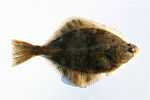 | Pleuronectes Flesus Platichthys flesus | [9] | ||
| 12. | Grayling |  | Salmo Thymallus Thymallus thymallus | [9] | ||
| 13. | Gudgeon |  | Cyprinus Gobio Gobio gobio | [9] | ||
| 14. | Brook Lamprey | | Not listed in 1829 Lampetra planeri | [14] | ||
| 15. | Lamprey | 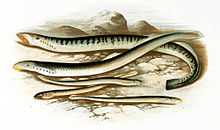 | Lamprey Nine eyed eel Lampern Seven eyed eel | Petromyzon Fluviatilis Lampetra fluviatilis | [9] | |
| 16. | Loach | | Groundling Loach Spined Loach | Cobitis taenia Cobitis taenia | [9] | |
| 17. | Minnow |  | Pink | Cyprinus Phoxinus Phoxinus phoxinus | [9] | |
| 18. | Perch |  | Common Perch | Percea Fluviatilis Perca fluviatilis | [9] | |
| 19. | Pike |  | Common Pike | Esox Lucius Esox lucius | [9] | |
| 20. | Roach | | Cyprinus Rutilus Rutilus rutilus | [9] | ||
| 21. | Rudd | 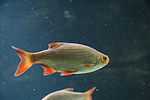 | Not listed in 1829 Scardinius erythropthalmus | [9] | ||
| 22. | Ruffe |  | Ruffe or Pope | Perca Cernua Gymnocephalus cernua | [9] | |
| 23. | Salmon | | Common Salmon Atlantic Salmon | Salmo Salar Salmo salar | Locally extinct but reintroduced | [12] |
| 24. | Sand eel |  | Not listed in 1829 Family Ammodytidae | [9] | ||
| 25. | Shad | .jpg) | Not listed in 1829 Genus Alosa | [9] | ||
| 26. | Smelt | 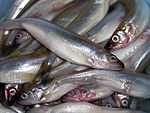 | European smelt | Not listed in 1829 Osmerus eperlanus | [15] | |
| 27. | Stickleback |  | Strickleback Common Stickleback Three-spined stickleback | Gasterosteus Aculeatus Gasterosteus aculeatus | [9] | |
| 28. | Sturgeon |  | European sea sturgeon Common sturgeon | Acipenser sturio Acipenser sturio | Locally extinct | [12] |
| 29. | Tench |  | Cyprinus Tinca Tinca tinca | [9] | ||
| 30. | Trout |  | Common Trout Brown Trout Whitling - young male | Salmo Fario Salmo trutta | ||
| 31. | Zander |  | Not listed in 1829 Sander lucioperca | Non native | [11] | |
See also
References
- ↑ 1.0 1.1 1.2 1.3 Glover, Stephen (1829). Noble, Thomas, ed. The History of the County of Derby. Mozley. pp. 166–171.
- ↑ 2.0 2.1 Stone, Richard (2005). River Trent. Phillimore. pp. 72, 101–102. ISBN 1860773567.
- ↑ "Faerie Queene. Book IV. Canto XI.". spenserians.cath.vt.edu. Retrieved 21 April 2013.
- ↑ Southey, Robert (1831). Select Works of the British Poets: From Chaucer to Jonson. Longman. p. 674.
- ↑ "An itinerary of Nottingham: Trent Bridge". Transactions of the Thoroton Society, 29 (1925). nottshistory.org.uk. Retrieved 10 June 2013.
- ↑ Walton, Izaak (1833). The Complete Angler ; Or, Contemplative Man's Recreation; Being a Discourse on Rivers, Ponds, Fish and Fishing. With Lives and Notes. p. 248.
- ↑ The Compleat Angler, (1653)
- ↑ Deering, Charles; Chicken, Rupert (1751). Nottinghamia vetus et nova: or, An historical account of the ancient and present state of the town of Nottingham. Printed by and for, G. Ayscough, & T. Willington. p. 163.
- ↑ 9.0 9.1 9.2 9.3 9.4 9.5 9.6 9.7 9.8 9.9 9.10 9.11 9.12 9.13 9.14 9.15 9.16 9.17 9.18 9.19 9.20 9.21 9.22 9.23 Glover, Stephen (1831). Noble, Thomas, ed. The History and Gazetteer of the County of Derby. Mozley. p. 29.
- ↑ 10.0 10.1 Cowx, I.G.; Broughton, N.M. (1986). "Changes in the species composition of anglers’ catches in the River Trent (England) between 1969 and 1984". Journal of Fish Biology (Wiley) 28 (1): 625–636. doi:10.1111/j.1095-8649.1986.tb05197.x.
- ↑ 11.0 11.1 11.2 11.3 Nunn, A.D.; Bolland, J.D.; Harvey, J.P.; Cowx, I.G. (2007). "Establishment of self-sustaining populations of non-native fish species in the River Trent and Warwickshire Avon, UK, indicated by the presence of 0+ fish". Aquatic Invasions (REABIC) 2: 190–196. doi:10.3391/ai.2007.2.3.6.
- ↑ 12.0 12.1 12.2 12.3 "Introductory Fish Pack". Leicester and Rutland Fish. naturespot.org.uk. pp. 17–18. Retrieved 10 February 2014.
- ↑ Worthington, T; Kemp, T.S.; Osborne, P.E.; Howes, C.; Easton, K.E. (2011). "A review of the historical distribution and status of the burbot (Lota lota) in English rivers". Journal of Applied Ichthyology (Blackwell) 27 (s1): 1–8. doi:10.1111/j.1439-0426.2011.01836.x.
- ↑ "Chemical spillage wipes out fish in River Trent". News in Brief (The Ecologist). 2009. Retrieved 10 January 2014.
- ↑ "The status of smelt Osmerus eperlanus in England". Report 516. Natural England. pp. 17–18. Retrieved 10 January 2014.